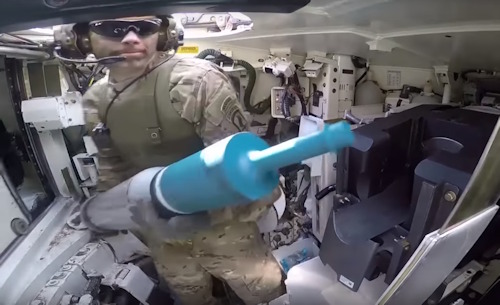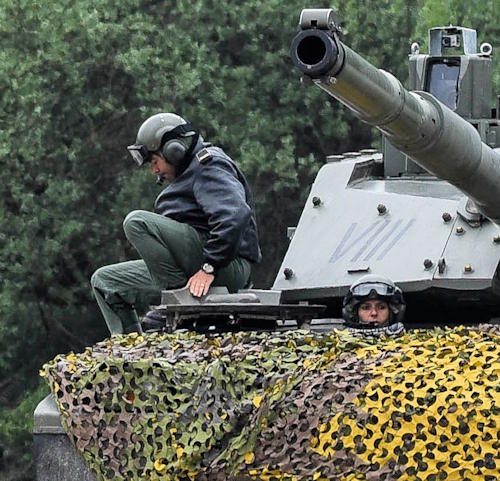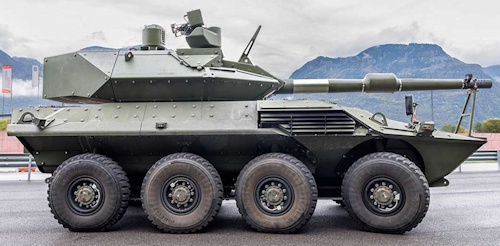Until a few years ago this joke was among the ranks of the Israeli army: what is the difference between a Zelda (Israeli version of the American troop transport M-113) and a match? The Zelda ignites first!
This joke (bitter) could run even among Italian tank crews. Online defense has come into possession of further information about the 22 June 2006 incident at the Torre Veneri military site in Puglia, which caused the death of a crew member of an MBT during an exercise. C-1 ARIETE.
The ARIETE battle tank is armed with an 120 / 44 piece that shoots ammunition with the fuel case (with the exception of the case back which is made of steel). These ammunition are stored inside the turret in the same arrangement used on the LEOPARD 1, armed with an 105 / 51 piece that uses ammunition with an entirely metal case. This type of case is designed to isolate the propellant dust contained in it from direct contact with free flames or overheated bodies.
The shell of the 120 ammunition, on the other hand, is made with a cellulose-based compound coated with a thin layer of protective varnish: as from tests carried out it begins to burn, in contact with a heated metal body, at a temperature of about 240 ° C.
 Western tanks of the same generation of ARIES (M-1 ABRAMS - picture on the right -, LEOPARD 2, LECLERC), which use the same model of ammunition, are equipped with armored reservoirs located in the rear area inside the turret, and separated from the rest of the environment by sliding partitions, open only for the time necessary for the withdrawal of a blow.
Western tanks of the same generation of ARIES (M-1 ABRAMS - picture on the right -, LEOPARD 2, LECLERC), which use the same model of ammunition, are equipped with armored reservoirs located in the rear area inside the turret, and separated from the rest of the environment by sliding partitions, open only for the time necessary for the withdrawal of a blow.
The basket collects cases of the ARIETE cart, due to its shape and size, does not guarantee the safe containment of the bottoms that fall into it (eyewitnesses witnessed the exit from the aforementioned basket on the bottom of the second shot fired by the 120 / 44 which, impacting the previous one, maintained sufficient kinetic energy to be able to climb over the wall of the collector).
The torch of the APFSDS DM-33 kinetic energy penetrator protrudes approximately 280 mm from the edge of the caseback and, after the shot, at the moment of ejection from the combustion chamber, the casing has a temperature of about 400 ° C.
In the aforementioned incident it happened that the bottom of the bottom, which jumped out of the collector basket, came into contact with the case of one of 4 shots which, without any protection, were located under the oscillating mass of the piece by 120 / 44.
The anti-fire system, installed on ARIETE tanks, uses a gas that, combining with the air, absorbs it in oxygen content, thus preventing the combustion of hydrocarbons. However it is completely useless in case of fire of the propellant powder as it contains oxygen in the molecules that compose it.
 Furthermore, the door available to the pilot should also be designed as an emergency exit, with an instinctive, rapid and safe operation. ma this was not considered in the design of the ARIETE wagon.
Furthermore, the door available to the pilot should also be designed as an emergency exit, with an instinctive, rapid and safe operation. ma this was not considered in the design of the ARIETE wagon.
In fact, to open the pilot's door it is necessary, as a first operation, to turn the bolt counterclockwise, pushing the left lever forward and pulling back the right one (already this opposite movement of the arms generates confusion, it would have been better if the movement had been symmetrical).
It is necessary to repeat this maneuver several times because, with a single action, it would not be possible to rotate the bolts to the extent necessary to free the door.
The following maneuver consists of operating a lever located to the right of the pilot, to release the vertical movement of the door, which should then be pushed upwards by the action of the balancing spring. Action that is thermosensitive, as this spring is calibrated during the winter period, with temperatures close to zero.
In summer, with temperatures above 30 ° C, as it expands, it loses resistance so that it is no longer able to lift the hatch to the necessary height. If the door is not raised, the seat backrest must be fully reclined, lie down, bring the knees to chest height, point the feet against the inner surface of the door and push upwards. This is because, in extreme cases, with the strength of the arms it is not possible to apply the necessary thrust.
If then the spring calibration takes place in summer, with the cold season the contracting spring makes it very difficult to close the door.
After having completely raised the door, it is necessary to act on another lever, to the right of the pilot, to allow the horizontal rotation to be released, in order to free the escape route.

All the operations described, unlike the LEOPARD 1, can be performed only from within the ARIETE, thus excluding any external intervention.
The accident of thirteen years ago caused the death of corporal Marco Bisconti, pilot of the wagon, and the wounding of the other 3 crew members. The investigation that followed did not identify either the subjective responsibilities, let alone the objective ones, and after 13 years no charge was made for the tragic death of Bisconti. In these cases there is always the well-founded suspicion of a cover-up (after the accident the drum volume was increased, however this change does not reduce the risk of accidental explosions inside the combat compartment).
Currently, at the Officine Marconi, three ARIETE tanks are being updated (with an allocation of 35 million euros), which includes the application of the changes already mentioned in the previous articles (more).
Although the military leaders had preferred (and supported) the acquisition of LEOPARD 2, the logic of politics prevailed over common sense.
As for the new CENTAURO II heavy armored car, a two-drum 120 feed system was designed - for the 45 / 6 piece with automatic loading - each stroke, from which to select the ammunition to be used. The two drums are physically separated from the combat chamber by armored doors, which separate the two environments. In the event of an internal explosion, the plates placed on the rear of the turret would give way, in order to let the explosion outward, limiting the risk of damage inside the vehicle.

Depending on the target to hit, the gunner chooses the most suitable ammunition, which is extracted from the drum.
In addition to the shots contained in the drums, there are those placed on special saddles on both sides of the rear part of the hull.
This compartment has two entrances: one external and one towards the combat chamber; in addition there are two openings to take the blows from the two lower deposits (also in this case, the roof of this compartment would yield to give vent to the outside to possible explosions).
The CENTAURO II will maintain a crew of 4 men, thus following the Israeli approach, as also the MERKAVA IV has 4 crewmen and is armed with an automatic loading cannon (in case of malfunction of the automatic loading, a man in more, it would be convenient).
The ARIETE update program does not provide for the compartmentalization with ammunition armored, as said by the technicians of Oto Melara (belonging to the Leonardo group), it would cause heavy ergonomic problems for the crew members. Furthermore, a compartmentalization would negatively affect the speed of shooting, considered essential for an MBT.
However, this lack, in our opinion, constitutes an element of considerable danger to the crew. Not only for the accidental ignition of one or more ammunition inside the combat compartment (as happened in the accident described above of the 2006) but also for the vulnerability of these to direct blows.
We only hope that in the future we will not have to complain about other victims due to ARIES deficiencies.
Photo: Italian Army / YouTube / US Army












